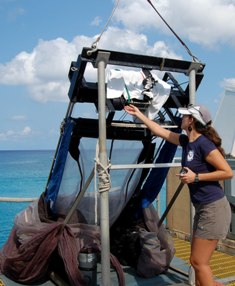NOAA helps out in Cayman’s fish larvae count
 (CNS): Scientists aboard a National Oceanic and Atmospheric Administration (NOAA) vessel currently in Cayman waters tracking and counting blue fin tuna larvae have agreed to help track Cayman’s endangered Nassau groupers as well, Department of Environment (DoE) officials have revealed. Scientists on board the RV Gordon Gunter have responding to a request from the DoE to add the counting of grouper larvae to their work-list. Given the battle to try and preserve what is considered to be one of the cornerstone reef fish, any new knowledge about their spawning or lifecycles can help in that fight.
(CNS): Scientists aboard a National Oceanic and Atmospheric Administration (NOAA) vessel currently in Cayman waters tracking and counting blue fin tuna larvae have agreed to help track Cayman’s endangered Nassau groupers as well, Department of Environment (DoE) officials have revealed. Scientists on board the RV Gordon Gunter have responding to a request from the DoE to add the counting of grouper larvae to their work-list. Given the battle to try and preserve what is considered to be one of the cornerstone reef fish, any new knowledge about their spawning or lifecycles can help in that fight.
“We are very thankful for this concession. Nassau grouper spawning events generally occur this time of year. With NOAA’s help we can learn a lot about the prevalence and path of grouper larvae and the information can strengthen our conservation efforts,” DoE Deputy Director Tim Austin said.
NOAA researchers use a Multiple Opening and Closing Net with an Environmental Sensing System (MOCNESS) to gather samples at different ocean sites and depths. These samples are then scrutinized in an onboard laboratory as scientists look for fish larvae.
“The MOCNESS is a high-tech sampling system and is towed behind the ship with nets opening and shutting independently to sample discrete patches of water. An array of sensors mounted on the instrument frame relays water conditions up to the ship in real time.
“The data allows researchers match what they find in their samples to the physical properties of the seawater,” NOAA Research Associate Estrella Malca explained.
The RV Gordon Gunter operates primarily in the waters of the Gulf of Mexico, the Atlantic Ocean and the Caribbean Sea, conducting scientific surveys to determine the health and abundance of fishery resources and marine mammals.
The vessel docked in Grand Cayman this week to allow staff to meet their DoE counterparts. The crew also hosted a group of marine science students from Cayman Prep and High School.
For more on the ship and its crew’s activities go to www.moc.noaa.gov/gu/
Category: Science and Nature


Thank you DoE and NOAA! Better hurry though.